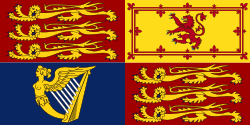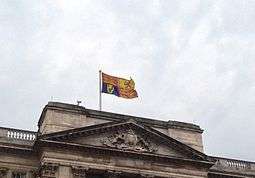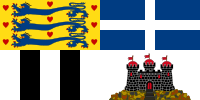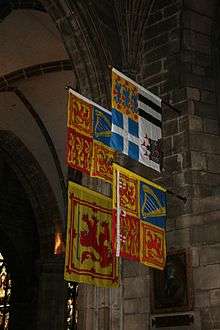Royal Standard of the United Kingdom

.svg.png)
The Royal Standard of the United Kingdom is the flag used by Elizabeth II in her capacity as Sovereign of the United Kingdom and its overseas territories. Different royal standards are used in the Queen's other realms, and the Royal Standard of the United Kingdom is varied for use in Scotland.
Although almost universally called a standard, such flags when used in the United Kingdom are banners of arms, as they comprise the shield of the Royal Arms. In other realms of the Monarch, the Royal Standard is usually the nation's banner of arms with a blue disc containing a wreath of gold roses encircling a crowned letter 'E', (for 'Elizabeth'), superimposed upon it (the Personal Flag of Queen Elizabeth II). Not all realms have an equivalent standard.
The Royal Standard of the United Kingdom is flown when the Queen is in residence in one of the royal palaces and on her car, ship or airplane. It may be flown on any building, official or private, during a visit by the Queen, if the owner or proprietor so requests. The Royal Standard was flown aboard the royal yacht when it was in service and the Queen was on board. The only church that may fly a Royal Standard, even without the presence of the Sovereign, is Westminster Abbey, a Royal Peculiar.[2]
When the Queen visited the United States in 1992, she was provided with a Cadillac limousine that flew both her standard and the Stars and Stripes, an acknowledgement of the "special relationship" that exists between the two nations.
The Royal Standard is flown at royal residences only when the sovereign is present. If the Union Flag flies above Buckingham Palace, Windsor Castle or Sandringham House it signals that the Queen is not in residence. In 1934, King George V permitted his subjects in Scotland to display the ancient Royal Standard of Scotland as part of his silver jubilee. Today, it flies above Holyrood Palace and Balmoral Castle when the Queen is not in residence.[1]
When the Queen attends Parliament at the Palace of Westminster, the Royal Standard flies from Victoria Tower.
Unlike the Union Flag, the Royal Standard is never flown at half-mast, even after the demise of the Crown, as there is always a sovereign on the throne.[2]
Controversy arose regarding the lack of a flag at half-mast over Buckingham Palace following the death of Diana, Princess of Wales, in 1997. The Queen was then in summer residence at Balmoral; and according to established custom, no flag was displayed over Buckingham Palace, as the monarch was not present. The Queen proposed a compromise whereby the Union Flag would be flown at half-mast on the day of Diana's funeral.[3] Since then, the Union Flag has flown regularly in the Queen's absence and has been lowered to half-mast to mark several occasions such as the death of Queen Elizabeth The Queen Mother,[4] the September 11 attacks and the 7 July 2005 London bombings.[5] The Union Flag was also flown at half-mast over Buckingham Palace as a mark of respect on the first anniversary of the death of Diana, Princess of Wales, on Bank Holiday, Monday, 31 August 1998.
England, Wales, Northern Ireland and overseas

In England, Wales, Northern Ireland, and outside the United Kingdom, the flag is divided into four quadrants. The first and fourth quadrants represent the ancient Kingdom of England and contain three gold lions, (or "leopards"), passant guardant on a red field; the second quadrant represents the ancient Kingdom of Scotland and contains a red lion rampant on a gold field; the third quadrant represents the ancient Kingdom of Ireland and contains a version of the gold harp from the coat of arms of Ireland on a blue field. The inclusion of the harp remains an issue for some in Ireland. In 1937 Éamon de Valera, then Taoiseach asked Dominions Secretary Malcolm MacDonald if the harp quarter could be removed from the Royal Standard on the grounds that the Irish people had not given their consent to the Irish emblem being included. The request was denied and the harp remains.[6]
The modern Royal Standard of the United Kingdom, apart from minor changes, (notably to the form of harp used to represent Ireland), dates to the reign of Queen Victoria. Earlier Royal Standards of the United Kingdom incorporated the Arms of Hanover and of the Kingdom of France, representing the title of Elector (later King) of Hanover and the theoretical claim to the throne of France, a claim dropped in 1800). The Hanoverian association terminated in 1837 with the accession of Queen Victoria who, being a female, could not accede to Hanover.
Famous Royal Standards of former British Monarchs include the Scotland Impaled Royal Standard of Queen Anne, the Hanover Quartered Royal Standards of King George I to George III, and the Hanover crowned Royal Standards of George III to William IV. The latter contained the Royal coat of arms of Hanover superimposed over what became the modern Royal Standard of the United Kingdom, although this particular standard's artistic representations of the banners of England, Ireland and Scotland in their respective quadrants was marginally different from the versions used today.
Scotland
In Scotland a separate version of the Royal Standard of the United Kingdom is used, whereby the red Lion Rampant of the Kingdom of Scotland appears in the first and fourth quadrants, displacing the three gold lions passant guardant of England, which occur only in the second quadrant. The third quadrant, displaying the gold harp of Ireland, remains unaltered from that version used throughout the remainder of the United Kingdom and overseas.
Other members of the Royal Family also use this Scottish version when in Scotland, with the only exceptions to this protocol being the consort of a queen regnant and the heir apparent, the Duke of Rothesay, each of whom has his own individual standard.
The Royal Standard of the United Kingdom used in Scotland differs from the ancient Royal Standard of Scotland in that the latter portrays the Lion Rampant in its entirety. As the banner of the Royal Coat of Arms of Scotland, the Royal Standard of Scotland remains a personal banner of the monarch and, despite being commonly used as an unofficial second flag of Scotland, its use is restricted under an act passed in 1672 by the Parliament of Scotland.
The Royal Standard of Scotland is used officially at Scottish royal residences, when the monarch is not in residence, and by representatives of the Crown, including the First Minister, Lord Lieutenants in their lieutenancies, the Lord High Commissioner to the General Assembly of the Church of Scotland, and Lord Lyon King of Arms. A variation of the Royal Standard of Scotland is used by the heir apparent to the King of Scots, the Duke of Rothesay, whose personal Royal Standard is the Royal Standard of Scotland defaced with an azure-coloured label of three points. (The banner of the Duke of Rothesay also features the same, displayed upon an inner shield).
Heir to the Throne
The direct heir to the Throne has several distinct standards and banners for use throughout the United Kingdom in representation of this position. Charles, Prince of Wales currently has five standards at use for his various roles and titles.
| Standard | Title | Description |
|---|---|---|
 | Prince of Wales | The Royal Standard of the United Kingdom, defaced with a three-point label. Superimposed is the arms of Llywelyn the Great —four quadrants, the first and fourth with a red lion on a gold field, and the second and third with a gold lion on a red field— crowned with the Prince's coronet.
Used in England and Northern Ireland, this standard was created in 1917. |
 | Prince of Wales | The arms of Llywelyn the Great. Superimposed is a green shield bearing the Prince's coronet.
Used in Wales, this standard was created in 1962 at the suggestion of Prince Philip. |
 | Prince and Great Steward of Scotland, Lord of the Isles, Duke of Rothesay | Quartered, the first and fourth a gold field defaced by a white and blue checkerboard band, the second and third a ship on a white background. Superimposed is the coat of arms of the heir apparent to the King of Scots.
Used in Scotland, this standard was created in 1974 at the suggestion of Prince Charles. |
 | Duke of Rothesay | The Royal Standard of Scotland, defaced with a three-point label in blue.
Used in Scotland, this is the ancient banner of the heir apparent to the King of Scots.[7] |
 | Duke of Cornwall | The flag is "sable fifteen bezants Or", that is, a black field bearing fifteen gold coins.
Used in Cornwall, this is the ancient banner of the Duke of Cornwall. |
Historic
| Standard | Title | Description |
|---|---|---|
.svg.png) | Prince of Wales | The Royal Standard of the United Kingdom, defaced with a three-point label. Superimposed is the coat of arms of the Royal House of Saxony. This standard was designated for the Prince of Wales from 1859 to 1917, at which time King George V renamed the Royal Family from the House of Saxe-Coburg and Gotha to the House of Windsor and renounced all German titles and claims in an act of British patriotism related to the ongoing First World War. |
Other members of the Royal Family
Other members of the Royal Family have personal standards of their own. These are variants of the Royal Standard of the United Kingdom, (including that which is used in Scotland), defaced with a white label and either three points or pendants (for children of a sovereign), or five points (grandchildren of a sovereign). Traditionally all princes and princesses of royal blood (i.e. descendants of the sovereign) are granted arms on their 18th birthday, thus giving them a banner to fly from their residences.
The following members of the Royal Family have personal standards, listed according to the line of succession:
| Standard | Member of the Royal Family | Description |
|---|---|---|
 |
Prince William, Duke of Cambridge | A three-point label, signifying a direct heir to the Throne, the second point charged with a red escallop taken from the arms of his mother Lady Diana |
 |
Prince Henry | A five-point label, the first, third and fifth points charged with a red escallop taken from the arms of his mother Lady Diana |
 |
Prince Andrew, Duke of York | A three-point label, the second point charged with a blue anchor |
 |
Princess Beatrice | A five-point label, the first, third and fifth points charged with a bee |
 |
Princess Eugenie | A five-point label, the first, third and fifth points charged with a Scottish thistle |
 |
Prince Edward, Earl of Wessex | A three-point label, the second point charged with a Tudor rose |
 |
Princess Anne, Princess Royal | A three-point label, the first and third points charged with the Cross of St. George, the second point charged with red heart |
 |
Prince Richard, Duke of Gloucester | A five-point label, the first, third and fifth points charged with the Cross of St. George, the second and fourth points charged with a lion passant guardant |
 |
Prince Edward, Duke of Kent | A five-point label, the first, third and fifth points charged with a blue anchor, the second and fourth points charged with the Cross of St. George |
 |
Prince Michael | A five-point label, the first, third and fifth points charged with the Cross of St. George, the second and fourth points charged with a blue anchor |
 |
Princess Alexandra, The Honourable Lady Ogilvy | A five-point label, the first and fifth points charged with a red heart, the second and fourth points charged with a blue anchor, the third point charged with the Cross of St. George |
Consorts of the British monarch
Queens consort of the British monarch are granted arms based on the Royal Standard and their own personal arms from before their marriage, or the arms of their family. In Scotland, a queen consort will use the Scottish version of the Royal Standard. They do not have different standards for the Commonwealth realms that have their own Royal Standards.
Consorts of a queen regnant are not granted use of the British Royal Standard. They use standards based on their own family arms.
| Standard | Consort | Details |
|---|---|---|
 | Consort of Elizabeth II (1948–present) | The Standard is based on the Duke's Greek and Danish roots. The flag is divided into four quarters:
The first quarter, representing Denmark, consists of three blue lions passant and nine red hearts on a yellow field. The second quarter, representing Greece, consists of a white cross on a blue field. The third quarter, representing the duke's surname, Mountbatten, contains five black and white vertical stripes. The fourth quarter, alludes to his title as Duke of Edinburgh, and includes a black and red castle which is also part of the city of Edinburgh's arms. |
 | Consort of George VI (1936–2002) | The Royal Standard, impaled with the arms of her father, Claude Bowes-Lyon, Earl of Strathmore and Kinghorne. |
 | Consort of George V (1910–1953) | The Royal Standard, impaled with the arms of her father, Francis, Duke of Teck, quartered with the Hanoverian coat of arms as used by her grandfather, Prince Adolphus, Duke of Cambridge. |
 | Consort of Edward VII (1901–1925) | The Royal Standard, impaled with the royal coat of arms of Denmark. |
Historic Royal Standards
| Standard | Member of the Royal Family | Description |
|---|---|---|
.svg.png) |
Princess Elizabeth, Duchess of Edinburgh | A three-point label, the first and third points charged with the Cross of St. George, the second point charged with a Tudor rose. |
 |
Princess Margaret, Countess of Snowdon | A three-point label, the first and third points charged with a Tudor Rose, the second point charged with a Scottish thistle. |
 |
Prince Albert, Duke of York | A three-point label, the second point charged with a blue anchor |
 |
Princess Mary, Princess Royal and Countess of Harewood | A three-point label, the first, second and third points charged with the Cross of St. George. |
 |
Prince Henry, Duke of Gloucester | A three-point label, the first and third points charged with the Cross of St. George, the second point charged with a lion passant guardant. |
 |
Prince George, Duke of Kent | A three-point label, the first, second and third points charged with a blue anchor. |
 |
Princess Alice, Countess of Athlone | A five-point label, the first, second, fourth and fifth points charged with a red heart, the third point charged with the Cross of St. George. |
Others


Other members of the Royal Family may use the Royal Standard of the United Kingdom, but within an ermine border, (a white border with black spots representing the ermine fur). This standard is mainly used for the wives of British princes, or members of the Royal Family who have not yet been granted their own arms. Diana, Princess of Wales, and more recently, Princess Alice, Duchess of Gloucester,[9] had this standard draped over their coffins at their funerals.
Camilla, Duchess of Cornwall, also enjoys the right to use this version of the Royal Standard although she rarely exercises it on her own. She received a grant of arms on 17 July 2005, which, based on past practice, could form the basis for her own standard if she ascends to become consort of the next king, however, officials have announced no such standard has yet been appoved.[10]
Just prior to her marriage in April 2011, Catherine Middleton received a grant of arms based upon those granted to her father, Michael Middleton. Like the Duchess of Cornwall, it is possible that these arms could form part of a future standard if she ascends to become Queen Consort.[11]
Uses of Standards

The Royal Standard is reserved only for the monarch, and is the most used. Most famously it signals the presence of the monarch at a royal residence, and is also used on official vehicles, primarily the Bentley State Limousine, but also on other road vehicles at home or abroad, often a Range Rover. The Royal Standard is also flown from aircraft and water vessels, including HMY Britannia and MV Spirit of Chartwell [12] during the Thames Diamond Jubilee Pageant. The flag is also draped over the coffin of the Monarch upon his/her death.
In some situations, personal standards are displayed within the UK, such as within St Giles' Cathedral, Edinburgh, (site of the Chapel of the Order of the Thistle), and St George's Chapel, Windsor Castle home of Banners of Knights of the Order of the Garter,[13][14][15] at the Thames Diamond Jubilee Pageant Prince Andrew's standard flew from MV Havengore.[16] However, the use of personal standards of other members of the Royal Family varies in frequency. The Prince of Wales flies his standard at Clarence House in the same way the Royal Standard is used over Buckingham Palace, but other members of the family tend not to fly theirs from their respective residences (though this may be due to the fact that many share official London Residences, as is the case at Kensington Palace).

Family members also do not use their standards on road vehicles, neither privately or during official engagements (when more discreet cars are used, such as Jaguar) or state occasions (when the Liveried cars of the Royal Mews are used), this seems reserved for the Queen only, although when Prince Philip travels alone at state occasions, his standard flies from the roof of his car, as seen with the funerals of Diana, Princess of Wales (when the Queen Mother also flew her personal standard from her car) and that of the Queen Mother, also, when a visiting Head of State on a state visit uses a car from the Royal Mews, his/her own flag is displayed.[17][18] That said, when abroad, the standards of members of the family may well be flown: examples include Prince Charles,[19][20] the Duchess of Cornwall[21] and Prince William.[22][23]
Personal Standards have been used to cover the coffins of The Queen Mother, Princess Margaret[24][25] and The Duke of Windsor.
See also
- Flags of the English Interregnum
- Member states of the Commonwealth of Nations, which includes their flags
- Royal standards of Canada
References
- 1 2 "The Royal Banner and Arms of Scotland". The Royal Household. Retrieved 2013-12-27.
- 1 2 "Royal Standard". The Royal Household. Retrieved 2013-12-27.
- ↑ "Blair Defends Royal Family Against Criticism". BBC News. bbc.co.uk. 4 September 1997. Retrieved 2013-12-27.
- ↑ "Crowds Grieve for Queen Mother". BBC News. bbc.co.uk. Retrieved 2013-12-27.
- ↑ "London bombings toll rises to 37". BBC News. bbc.co.uk. Retrieved 2013-12-27.
- ↑ "Media Factsheet: Queen Elizabeth II's State Visit to Ireland". Discoverirelandmedia.com. 17 May 2011. Archived from the original on 24 March 2012. Retrieved 2013-12-27.
- ↑ Griffith, John (4 August 2003). "Standard of the Duke of Rothesay and Lord of the Isles for Scotland". Flags of the World. Retrieved 2013-12-27.
- ↑ "British Flags - Royal and vice-regal flags". Flags.net. Retrieved 2011-12-29.
- ↑ "Final Royal farewell to princess". BBC News. bbc.co.uk. 5 November 2004. Retrieved 2013-12-27.
- ↑ "The Coat of Arms of HRH The Duchess of Cornwall". College of Arms. 17 July 2005. Retrieved 2014-03-21.
- ↑ "The Arms of Miss Catherine Middleton". College of Arms. 19 April 2011. Retrieved 2014-03-21.
- ↑ Mbiyu, David (3 June 2012). "Diamond Jubilee flotilla adds color on the Thames". Demotix.com. Retrieved 2013-12-27.
- ↑ "Prince William and St George's Chapel". College of St. George. Retrieved 2013-12-27.
- ↑ "Tour: The Quire". College of St. George. Retrieved 2013-12-27.
- ↑ "Gallery of Wanamaker Flags". Flag Heritage Foundation. Retrieved 2013-12-27.
- ↑ "Diamond Jubilee: Thames River Pageant". Zimbio.com. 2 June 2012. Retrieved 2013-12-27.
- ↑ "Kuwaiti Emir al-Sabah continues UK state visit". Demotix.com. 29 November 2012. Retrieved 2013-12-27.
- ↑ kenjonbro. "Bentley State Limousine". Flickr. Retrieved 2013-12-27.
- ↑ "A Brush With Royal-tea! Prince of Wales: A Tea Review I". Alice and the teacup. 17 November 2012. Retrieved 2013-12-27.
- ↑ Campion, Vikki; Matheson, Melissa (9 November 2012). "Foul weather follows Prince Charles and Camilla". The Daily Telegraph. Retrieved 2013-12-27.
- ↑ "HRH Camilla Duchess of Cornwall's visit to Victoria Barracks, Sydney". Radical Royalist. 9 November 2012. Retrieved 2013-12-27.
- ↑ "William and Kate jet off on Canada trip". BBC News. bbc.co.uk. 1 July 2012. Retrieved 2013-12-27.
- ↑ "Kate & William's Diamond Jubilee Tour Highlights". The Royal Post. 19 September 2012. Retrieved 2013-12-27.
- ↑ "2002 News Events: In Pictures". Zimbio.com. 14 February 2002. Retrieved 2013-12-27.
- ↑ "Princess's coffin moved to Windsor". BBC News. bbc.co.uk. 14 February 2002. Retrieved 2013-12-27.
Further reading
- Davies, Norman (1999). The Isles: A History. Palgrave Macmillan.
.svg.png)